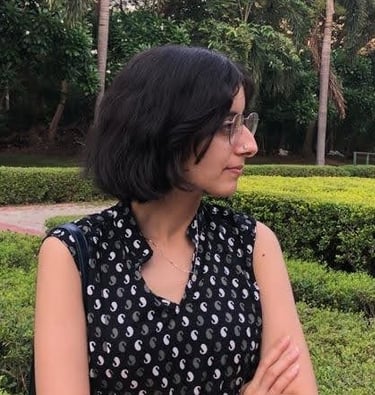UNDRESSING DRESSING UP
ALM No.82, November 2025
ESSAYS


On an unremarkable Sunday afternoon, I lay in bed at the mercy of Instagram and its minute-made content. As I strained my finger with what must amount to kilometers of scrolling, I happened upon a Swaddle piece in their Woe is Me section. A descendant of the Ask Alice and Agony Aunt advice columns of the world, this edition featured the grievance of a young girl who is troubled by her parents’ constant assertion about how she isn’t “girly” enough. I only ever pause at these to marvel at the unadvisable advice people have to offer in the comments section. However, in this instance, something about the piece rang familiar to me. At the time, I was a 25-year-old woman, who had never been inclined towards the traditional ideas and efforts of femininity. I had always taken pride and found comfort in getting by with what satisfied me as the bare minimum. The clothes I liked, occasionally a pair of earrings that seemed irresistible. Essentially, anything that I still felt like myself in. For the longest time, until my early 20s, my parents didn’t really care to comment, even if they did take notice. However, increasingly, as a long line of cousins began to get married one-by-one, the combined weight of the expectations of femininity and the idea of value associated with it began to dawn upon me.
A week later, a friend of mine shared a similar experience with me. In her case, the idea of value associated with dressing-up, particularly for women, was laid bare in much plainer terms than for me. A new concern about the waning beauty and descent of youth had been planted within her, and she told me how the possibility of marriage as an alternative (both of us have little desire for or faith in the institution) in a future that we are still unraveling and building, diminishes in a society like ours in the absence of beauty. Beauty, which plainly put, is a parameter of value for women. In essence, performing femininity in traditionally accepted ways increases your odds at marriage, and so, regardless of whether or not you aspire to marriage, not performing femininity undermines your value as a woman.
Disheartening as it was, it also made me want to look closer at the scale of this experience of not being “woman enough” that had been a constant presence in my life since puberty. And investigate the scale of this experience that several women, in their resistance against this mould of femininity—often just a consequence of their desire to express their individuality and live their truth — undergo. Doubtlessly, the group that I speak of understands this phenomenon and the coded ways in which South Asian society, with family as its strongest enforcer, tells women to be more woman-like, but for the rest of the world, an undressing of “dressing-up” might be worthwhile.
Growing up, the idea of dressing-up is wrapped in such innocent play for little girls and aspired to as such. We see women around us who are called pretty and have curious little potions in bottles that enhance their beauty, our mothers and older sisters, and we love it! These are the gender role models we have and they inspire in us a sense of affection and aspiration. You could also blame my mother here for portraying a woman who was evidently smart, confident, sported cropped hair, plaid shirts and trousers in her youth. She spoke up in discussions amongst men, sitting around the coffee table, and to some degree, digressed from the traditional gender roles of the society she inhabited in Jammu. She looked lovely in the simplest ironed cotton salwar kameez and to this day, I prefer that to a dressed-up version of her. My idea of a female role model, to my great relief, was based on holding your own, as I saw her do. Furthermore, her role models, my aunts, strong, independent women living in a world of men, raised her, travelled the world, and never married. Their existence further assured a childhood-me that womanhood ought to be about independence and strength, and the traditional ideas of dressing-up didn’t stick as well.
However, time turned the tables on us. I pursued and developed the convictions that they unknowingly planted the seeds of, and age and experience softened them to tradition in a way where they now sat facing me, asking me to “wear more color”. The real shame, I think, is the fact that my mother, in equal parts annoyed and helpless, urges me to wear what some girl wore somewhere, so that nobody thinks my inability or refusal to present as feminine enough or dress-up, is her failure as a mother and a woman. While I maintain, that even at 60 years of age, whenever she wears what she likes, my mother is the prettiest woman in any room.
The fact that I was averse to traditional ideas of dressing-up, sometimes frustrated some of the women around me. I liked to imagine it stemmed from my refusal to fall in line. Not to suggest any of these women were aware of this as I resisted their persistence to have me put on just a “very light shade” of lipstick. Usually, these would be women I am close and affectionate toward. Women that I engaged with as an equal on most days. However, on the days when I refused to conform, my refusal would be infantilized and a hierarchy of womanhood would enter our dynamic. An assertion of how I am not being a woman the right way and so I am less of one.
Last year at a relative’s engagement party, I showed up draped in a rust colored silk saree and a pair of red stone earrings that are a valued, though inexpensive, possession. The next day, at an extended family dinner, as I sat on one end of the couch watching the television, an aunt mildly chastised my mother in loud whispers about my completely plain appearance at the engagement and apprehensions about how I would present to the relatives of the family I marry into. Based on their physical proximity and the volume of the conversation, it took me a moment to register that it was, in fact, me they were talking about, followed by dismissing it as ridiculous and irrelevant, and finally, to my surprise, being enraged at being unabashedly valued and discussed in the third person in front of me. It reminded me of another friend, who was being increasingly pressured by her family to get married. A thoughtful activist, poet, artist and curator, my friend told me how with all that she knew herself to be and her accomplishments, she felt reduced to mere marital value in those moments. Nothing that she had done or was, seemed to matter.
The resilience of our ideas of normal lies in unquestioning adherence. Most people propagate patriarchal ideas of femininity likely unconscious of how they are built upon the idea of women as desirable wives: spelling out marriage as an inevitability for the definition of Indian or even South Asian ideas of womanhood. It is even more unlikely that presented with this argument, they would see how objectification and overt sexualization of women in popular culture is not very different from objectification within the marriage market. They are both restricting notions, seeking to regulate women’s bodies and behavior. The dichotomy of Madonna and the whore, a global patriarchal staple, is just another attempt at driving a wedge through the threat that is female solidarity. Liberating women from the norms of femininity can allow for a solidarity that includes not only cis-women but people of all genders, sexualities, and anyone who isn’t invested in retaining reductive and suffocating definitions of the self.
It is a terrifying idea for the keepers of normal; there is an appeal to residing in the walled but secure stronghold of patriarchal norms. But in this debate about value, to identify what remains of value to oneself is integral. Knowledge is its own reward in a world where we can change little. To know oneself, to arrive at whatever lengths of self-realization one can, and to fight the battles that keep you from that singular treasure — becoming and getting to know the person that you are — seems to me a valued and worthwhile endeavor in the brief lives we lead.
Marred by ideas of a womanhood that is at a crossroads, women can still take the encumbered road to self-hood and hopefully find companions. Like the ones that got us this far, raising us in shared silences, unwavering comfort, celebrated friendships, passing mutual despair, and unacknowledged persistent hope. In the struggle that faces us, which demands a commitment to the self that precedes any traditional relationship, women everywhere can yet, help redefine womanhood, to quote Adrienne Rich, in their “newly released courage to name, to love each other, to share risk and grief and celebration.”
Aditi Sundan is a writer, editor and climate communicator based out of New Delhi. Hailing from Jammu and Kashmir in India, she has spent much of her life engaging with ideas of justice in a world that increasingly seeks to turn away from them. Her journey and work across different cities has informed her inquiry of cultural norms and the way people of different identities occupy space in public and private. Aditi has a Masters Degree in English Literature, and when she isn’t wrestling with unfinished drafts, she attempts to teach herself how to play Claire de Lune on the piano, with little success.

